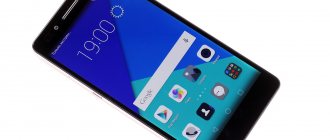Honor 10 should not be confused with Honor View 10 - these are different smartphones from Huawei that were released in 2021. The confusion is serious, although both flagships differ from each other even in appearance. We presented a review of Honor View 10 yesterday – you will find it here.
And now it’s time to look at Honor 10 - it just went on sale for 27,000 rubles (version with 64 GB of memory).
Characteristics
- OS: Android1 under EMUI 8.1.0 shell.
- Screen: IPS matrix with a diagonal of 5.84 inches. Full HD+ resolution: 2280×1080; pixel density – 432 per inch.
- Dual camera with resolutions: 16 and 24 megapixels. The apertures of the two modules are f/1.8.
- Front camera with a resolution of 24 megapixels and f/2.0 aperture.
- Processor: HiSilicon Kirin 970 with Mali-G72 MP12 video core. As of mid-2021, this is the most powerful solution from HiSilicon (a subsidiary brand of Huawei), which was previously used in the Mate 10 Pro and the new flagship Huawei P20. A special feature of the chip is the presence of a neural computing module to support AI technology.
- LTE modem cat.13, providing data transfer speeds of up to 400 Mbit/s in 4G networks.
- Set of interfaces: NFC, Bluetooth 4.2. There is even an infrared port for controlling household appliances. The Troika card is easily linked to NFC, plus it is possible to “link” three smartphones via NFC to simultaneously play one track. This will provide surround sound and volume. However, the phones must be connected to the same Wi-Fi network.
- There is face scanning technology for unlocking, although it does not work well. To remove the block on the face, the lighting must be ideal (the block cannot be removed in the dark). It will also not be possible to unlock a smartphone with glasses if the face was registered without them.
- 4 GB RAM and 64 GB memory. There is a version with 128 GB of memory.
- Battery 3400 mAh.
Taking into account the hardware, one would expect artificial intelligence technology for cameras in a smartphone, which itself determines the scene and sets the plot for it. The same “trick” is in the P20 and Honor View 10.
Review of the Honor 10 smartphone - strength, beauty and intelligence
Honor is a sub-brand of the Chinese giant Huawei, aimed primarily at young people, while its model range differs minimally from the models released under the company’s main brand. Honor 10, being a logical continuation of the very popular ninth version, largely repeats the flagship Huawei P20, but costs noticeably less.
I won’t be modest and before starting the story directly about the smartphone itself, I’ll note that Honor 10 was recently awarded the prestigious EISA Awards in the category “best lifestyle smartphone EISA 2018-2019.”
EISA (“European Imaging and Sound Association” or “European Association of Audio and Video Magazines”) is a European organization that has existed since 1982, uniting more than 50 specialized publications on audio and video equipment from 19 European countries. Based on the results of independent expert assessments of participating members, the best examples of audio/video equipment are annually awarded the EISA Awards in various categories. Models of equipment, reviews of which have been published in at least five journals of participating members, are eligible for the nomination. The applicant product must go on sale no later than October 1 in at least 10 European countries.
The device received its award for “a design with a variety of color options,” as well as “the presence of a powerful processor with a separate NPU to provide artificial intelligence functions,” among which the advanced camera capabilities were highlighted.
Honor 10 has also received over 10 awards from industry media, including Android Headline's Editors' Choice, Wired's Best Mid-Range Smartphone, Android Central's Best Smartphone Under $400, Tech's Best Smartphone of 2021 Radar, as well as "Best Pocket-Lint Smartphone of 2021".
So let's take a closer look at it.
- Model code: COL-L29A
- Case material: Aluminosilicate glass
- OS: Android 8.1.0
- Shell: EMUI 8.1.0
- Processor: Huawei Kirin 970
- Number of cores: 8-core, 4×Cortex A73 2.36 GHz + 4×Cortex A53 1.8 GHz
- Screen type: LTPS
- Diagonal (inches): 5.84
- Screen resolution: 2280×1080
- Pixels per inch (density): 432
- Built-in memory: 64 GB, 128 GB
- RAM: 4 GB
- microSD card support: Does not support
- Main camera (MP): 16 MP + 24 MP
- Autofocus: Yes
- Flash: Yes
- Video recording: up to UHD 4K
- Front camera (MP): 24 MP
- Video recording: up to 1920×1080
- SIM card type: Nano
- Number of SIM cards: 2
- SIM card operating mode: Alternating
- 2G: GSM 1800, 1900, 850, 900 MHz
- 3G: WCDMA B1 2100, B19 850, B2 1900, B5 850, B6 850, B8 900 MHz
- 4G: FDD B1 2100, B19 800, B20 800, B3 1800, B5 850, B7 2600, B8 900 MHz, TDD B38 2600, B40 2300, B41 2500 MHz
- Wi-Fi: 802.11 b/g/n, 2.4 GHz/ 802.11 a/n/ac, 5 GHz
- Wi-Fi Direct: Yes
- Bluetooth: BT4.2, BLE, aptX and aptX HD, LHDC
- FM radio: No
- Built-in sensors: light, gyroscope, G-sensor, compass, hall
- Fingerprint scanner: Yes, on-screen ultrasonic
- Face Unlock: Yes
- NFC: Yes
- IR port: Yes
- USB: 2.0
- Positioning systems: GPS/BDS/GLONASS
- Battery: 3400 mAh, non-removable
- Weight g: 153
- Dimensions (WxHxD mm): 149.6 x 71.2 x 7.7
Equipment and appearance
The manufacturer's kit includes a protective film (glued to the screen), a thermo-polyurethane protective case, a “needle” for removing the SIM card tray, a charger with support for fast charging Honor Super Charge, a Type-C USB cable, and Huawei branded headphones. Half in-Ear Headphones Lite, plus quick start guide and warranty card.
The model is offered in four colors and in this case in the review there is a blue version.
From the front, Honor 10 is very similar to Huawei P20 and even their dimensions are almost the same, except that the frames around the screen are a little wider.
In the traditional cutout at the top of the screen, which is often called the word “unibrow,” there is a front camera, a speaker, a light sensor, and a small LED for indicating events.
The fingerprint scanner is located in front under the screen on a rather thin bottom strip under the protective glass, its border is indicated by a dotted line, and without a protective film it will be possible to confidently enter this area blindly only after some training. It is worth noting that this design decision did not affect the response speed in any way, the scanner is very fast and no lag is felt compared to “regular” ones.
Like the Huawei P20, on the bottom edge you can find a multimedia speaker, microphone, Type-C and Mini Jack connectors for connecting a headset, on the top there is a noise-canceling microphone hole, as well as an IR transmitter eye.
On the left side there is a tray for two nano-SIM cards, on the right there is a volume rocker and a power button.
The back panel is made of glass with Gorilla Glass protection. Thanks to the rounded edges and light weight, the smartphone fits well in the hand, but the glass back panel turns out to be quite slippery, so it may well slip out of sweaty hands. To be more confident, you still need to use a protective case.
The shape of the case as a whole is borrowed from the previous, ninth version of Honor - the same slightly smoothed sides, the same multi-layer coating that changes the pattern depending on the viewing angle, but the 10 also changes color: when viewed directly, the smartphone shimmers with interesting stripes on the blue, and when the body deviates, the color gradually fades into purple shades. In reality it looks interesting and even quite fascinating.
In the upper left corner there is a dual camera consisting of a 16-megapixel main and 24-megapixel monochrome modules, as well as an LED backlight. Unfortunately, the camera block protrudes significantly above the plane of the back surface of the device, which in turn allows dust and other unpleasant dirt to accumulate here.
Screen
Despite the fact that Honor 10 is in many ways similar to the Huawei P20, the screen was borrowed from the P20 Light model, it is made using IPS technology, the diagonal is 5.84 inches, and the aspect ratio is 19:9. The screen resolution is 1080x2280 pixels, the pixel density is about 432 ppi, the maximum brightness is enough to make out the information on the display on a sunny day, but under direct sunlight the screen noticeably fades.
The color gamut in bright mode (Vivid) is very large, the picture turns out juicy, saturated, but with a coolish tint. If you wish, you can easily fix this in one of two ways: either switch to warm mode in the “color mode and temperature” menu, or activate eye protection and use the slider to adjust the color temperature to your liking.
Although the smartphone is relatively small and light, it is still not as convenient to operate it with one hand as we would like - the large diagonal of the screen, reaching almost 6 inches, has an effect.
By the way, the “unibrow” at the top of the screen can be disguised if desired by turning on the corresponding option in the settings and adding black stripes on the sides.
Operating system and features
Honor 10 runs Android 8.1 with the Emui proprietary shell of the same version. By default, there is no application menu, and they are all located on the home screen, but if you wish, you can switch to the interface option familiar to Android users.
Also in the shell there is a kind of simplified mode, which in appearance resembles Windows Mobile, in which all the main functions are presented in the form of large “tiles”. It is striking that the company has tried very hard to make this smartphone as user-friendly as possible and has equipped it with many different pleasant functions, for example, here you can configure the unlocking of the smartphone by the owner’s voice, there are also built-in tools for blocking applications and encrypting files, and system navigation settings allow you to choose one of four control options:
— standard on-screen Android buttons;
— gestures using the fingerprint scanner (very convenient);
— “smart” navigation bar with gesture support;
— a floating navigation button that can be placed at any point on the screen convenient for the user.
Among the proprietary system utilities, we can note a theme manager, a very detailed and high-quality built-in reference book translated into Russian, a training manager, its own audio-video player, a photo gallery and a virtual remote control. I was pleased that after a long period of operation the system does not become clogged with “garbage” and due to this everything works very quickly and smoothly. In fact, I was very impressed by the quality of the shell and the huge number of different nice functions, the description of which requires a separate review.
Hardware and performance
Huawei has abandoned third-party developments quite a long time ago and independently produces its own chipsets for mobile devices. Honor 10 was no exception and therefore the Kirin 970 SoC is responsible for performance here. Specifications of the Kirin 970 include four energy-efficient Cortex-A53 cores with a frequency of 1.8 GHz and four high-performance Cortex-A73 cores with a frequency of 2.4 GHz, for graphics answers Mali-G72 MP12, the system allows hardware video decoding [email protected] and encoding [email protected]
Kirin 970 is essentially Huawei's flagship chipset, characterized not only by very high performance characteristics comparable to Qualcomm Snapdragon 835, but also by the presence of a dedicated Neural Processing Unit (NPU) designed to work with artificial intelligence (AI) technologies. By the way, as for performance in this direction, there are results of comparative tests on the Internet, according to the results of which the Kirin 970 even slightly outperforms the generally much more productive Qualcomm Snapdragon 845.
In conjunction with the processor, there is 4GB of RAM, as well as 128GB of internal memory (or 64GB depending on the version).
In the Antutu Benchmark performance test, the smartphone scores about 205,000 points, only slightly inferior to its “big brother” Huawei P20 and keeps on par with OnePlus 5 (Qualcomm Snapdragon 835 SoC), while occupying 22nd place in the overall rating of all mobile devices tested at that time . Testing in several other popular benchmarks also confirms the good result obtained. The world of tanks at maximum settings, in an open field, when mostly friendly units are nearby, lives comfortably at 60 frames per second. A high frame rate is also observed during long-range firefights, however, in close combat the performance sometimes drops to 40 FPS, which in itself is not critical and will not affect the advantage gained in battle, but, nevertheless, for a comfortable game in large “messages” the graphics have meaning to lower.
In PUBG Mobile, with maximum graphics settings and anti-aliasing enabled, we get playable FPS in the average range from 30 to 40.
As always, you have to sacrifice something for a powerful processor, and since we are looking at essentially a productive, but not a gaming smartphone with a dedicated cooling system, the body of the device becomes noticeably hot under prolonged heavy load.
As for the quality of communication and wireless interfaces, you shouldn’t expect anything negative here from Huawei - this is in perfect order, the device perfectly supports 4G on both SIM cards, the speaker is loud and does not distort the interlocutor’s voice, and the microphone with an active noise reduction system copes with its the task of cutting off all extraneous noise and echo.
Since Honor 10 is positioned as “youth”, the manufacturer did not forget about high-quality sound, equipping the model with a dedicated 32-bit AK4376A DAC and Huawei Histen technology. The sound in the headphones is good enough for a user listening to music from a smartphone, although I would like a little more volume headroom.
To improve the sound in the headphones, audio effects are used that can make the sound more rich and spacious; there is also a 10-band equalizer with presets for different music genres and even optimization for different types of headphones. Unfortunately, although the supplied headphones are branded, they are of a basic type and do not allow you to reveal the full potential invested in the model, producing a “flat” sound, so they can only be used if there is no more suitable alternative. In high-quality headphones, tracks of different genres sound clear and rich.
The external sound was quite surprising, despite the fact that Honor 10 is equipped with only one multimedia speaker, it has good volume, does not rattle and does not distort the mid frequencies very much, producing a fairly decent sound for its size.
Cameras
The Honor 10 camera application is simply equipped with a huge number of all sorts of “tricks” in the form of filters, “embellishments”, image conversion into “haircuts”, 3D facial recognition functions and animated emojis with the ability to use them in real time when recording video.
There is also a very interesting “Scanner” mode. Imagine yourself as a spy who doesn’t have time to adjust the position of the camera to get a photocopy of a top-secret document and everything needs to be done as quickly as possible - this is roughly the feeling you get when using this function. By pointing the camera at a book/magazine/newspaper, you can allow the system to independently determine the angle and size of the object and take a photo to obtain a well-readable result, which can be recognized in the future with high quality thanks to the high resolution.
Honor 10 borrowed a lot from the Huawei P20, including the front 24-megapixel camera it also inherited. But the rear camera from Leica apparently turned out to be a little expensive for the youth line, so it was replaced with 16-megapixel color and 24-megapixel monochrome sensors with an f/1.8 aperture; in addition, the camera does not have optical stabilization and uses conventional phase detection autofocus. But nevertheless, the main feature of the Huawei P20 remains here - the AI module built into the processor itself determines the genre of the photo and carries out appropriate optimization.
Also, Honor 10 has slightly improved the interface and turning on/off AI mode is now on the main screen, and not “somewhere in the settings”.
The quality of pictures on a sunny day is high, they turn out to be quite detailed with a low noise level, natural colors and a good dynamic range. With the AI mode activated, in most cases the colors become more saturated, the clarity in high-contrast scenes increases, as if a designer had worked on the picture in Photoshop. AI works very correctly and in most cases really improves the picture; it can be kept on by default and turned off only if you need to take black and white images, or if the neural networks are too overdone.
You can also turn AI mode off and on off-line, i.e. in photos already taken - this is very convenient when choosing the best option and clearly demonstrates the “before and after” condition.
| AI enabled | AI off |
I also propose to make a small comparison of the camera with the Nokia 7 Plus.
The main camera of the Nokia 7 Plus is dual, using a 12 megapixel module with Zeiss optics with an f/1.75 aperture.
| Honor 10 | Nokia 7 Plus |
Original photos are available.
Battery and autonomy
Honor 10 has a non-removable battery with a capacity of 3400 mAh. The smartphone supports the proprietary Honor Supercharge fast charging technology, with which it charges from zero to 65% percent in about half an hour, and it will take a little less than an hour to get the rest, while the battery does not heat up very well.
In the battery benchmark, the smartphone lasted a little less than seven hours, in the “watching HD video” mode the result was about 15 hours, in normal mode the smartphone can last a day under average load, i.e. at the end of the working day, about 50% of the charge remains, but if there are not many calls and mobile Internet, then you can last up to two days with low usage.
Conclusion
As expected, Honor 10 turned out to be a somewhat simplified version of the Huawei P20 with a noticeably lower cost, for which the buyer has to pay for a slightly weaker camera module, the lack of optical stabilization and the lack of dust and moisture protection that the P20 has.
Also worth noting among the minuses is heating during active use, as well as the presence of a fashionable, but not everyone’s favorite unibrow, which, fortunately, can be hidden without resorting to third-party applications.
Otherwise, Honor 10 turned out to be a very productive model with an interesting and unusual design, which you will agree is also important, the communication quality is simply excellent, branded features built into the shell in the form of unlocking the smartphone by voice, by face, using a finger - all this works like a clock and with Over time you get used to these little things. The presence of NFC, a good camera with AI, decent battery life, a dedicated audio chip, and even such a banality as the presence of a 3.5 mm Audio Jack, which for some reason has come to be considered a relic of the past.
At the time of publication of the review, Honor 10 with 128 GB of internal memory was selling for $379.99.
Find out the current cost
Thank you for your attention and good luck to everyone!
Design
Most users and reviewers call the smartphone beautiful, but in reality it has an Apple-inspired appearance with a disgusting “unibrow” at the top. It contains a speaker, front camera, proximity and light sensor. The frames are thin, the screen area is 86%.
A special feature is the Ultrasonic fingerprint scanner hidden under the glass (not the screen). The glass itself is presumably Corning Gorilla Glass 5. The back panel shimmers pleasantly and changes colors, which has already become a tradition for the Honor line. The two rear cameras with the small “Ai Camera” inscription stick out unpleasantly from the body - this is a technical drawback of the sensors themselves, which have a fixed thickness. The manufacturer manages to create a thin body, but cannot “fit” thick camera sensors with lenses into it.
On the bottom panel there is the popular USB Type-C, 3.5 mm jack and speaker. The presence of a wired headset jack will please many users who have cool headphones - they can be used with Honor 10.
In general, the design is standard - like most flagships.
Setting up the keyboard on your smartphone
By default, the Honor 10 smartphone has the popular keyboard for Android devices installed - Swiftkey. It has flexible settings; any of its elements can be changed if you don’t like it. You can choose the keyboard type, change the location of additional buttons or the keyboard background. In the settings you need to select the “System” section, then “Language and input”, “Swiftkey keyboard”.
Select "Language & Input"
In this section, you can create a new profile in which you can select the necessary parameters.
SwiftKey keyboard settings menu
They will be saved and can be applied at any time if a failure occurs with the current settings. Or you will quickly want to change them. You can create several profiles for the keyboard. And use them one by one. Select the desired section from the menu to configure keyboard elements. The Honor 10 smartphone allows us to customize any of its tools: time, camera, NFS, screen, notifications, fingerprint.
Display Huawei Honor 10
Unlike other brands, Huawei is not yet seeking to purchase “tons” of Amoled screens from Samsung. Honor 10 uses a 5.84-inch IPS display with Full HD+ resolution and a pixel density of 432 per inch. LTPS technology was used in manufacturing, which provides wide viewing angles, more accurate color rendition, and lower power consumption.
There are many presets in the display settings - from “warm” to “cold”, the brightness level is high (also adjustable). The touchpad used recognizes up to 10 simultaneous touches. To save energy and improve performance, the resolution can be changed to a lower one, and “eye protection” is present, although there is nothing unusual about it.
conclusions
In Honor 10, the developers added good cameras with high resolution, high-quality hybrid zoom, artificial intelligence and more functionality. The smartphone takes excellent pictures in automatic mode; the user can take out the device, take a photo even using hot keys, and then put the phone back. This is the main merit of artificial intelligence, which independently selects the desired scene, adjusting the quality of the image.
For the average user who is not a professional photographer, the Honor 10 is a great option. Fast focusing, accurate white balance, correct and rich colors. This smartphone can handle any task, with the exception of night photography. If the user wants to get a clear image, then a tripod is indispensable. Share link:
5 / 5 ( 2 voices)
Partner news and advertising
Performance
HiSilicon Kirin 970 is the latest 10nm mobile chipset used in Huawei smartphones. The flagship module was previously installed in Mate 10 pro and P20, P20 Pro. Its potential is fully revealed, the capabilities are known, there is a built-in module for neural calculations, which is used to implement a “smart camera”.
In the Huawei P20 Pro set, we have already given the chipset parameters. If you're interested, here you go.
Instructions for Honor 10 for setting up the camera
Manually setting up photo and video cameras on a smartphone is a task for professionals. The developers at Honor know this, so they equipped the device with a smart camera.
Smart camera in Honor 10
It automatically adapts to the surrounding environment, and itself activates the necessary modes and settings for maximum image quality. The Honor 10 camera has many ready-made presets. You just have to select them by name. If you are photographing food, select the appropriate settings from the list.
Choose the right camera preset for your photo
The “smart camera” operates based on a neural network. By pointing it, the phone determines what is in front of it. And it automatically turns on the mode that is most suitable in a given situation.
Cameras
Everyone in the know knows about Huawei’s cooperation with the Leica brand. If this collaboration takes place, then the Leica optics inscription appears next to the cameras. In Honor 10 there is no information about Leica’s work on cameras, but the unique operating principle of the two modules remains:
- The first module is a 16-megapixel color sensor with f/1.8 aperture optics. Its purpose is to collect information about the color of the scene.
- The second module is monochrome with a resolution of 24 megapixels and an f/1.8 aperture. It collects information about light.
The collected data is combined using a special algorithm, and the user receives a high-quality frame with accurate colors and visible details in dark and light areas of the scene. Only Huawei uses this dual-camera approach; other manufacturers use a second camera to determine depth of field.
Focusing in Honor 10 is instant, shooting with the Bokeh effect is present, 2x zooming is possible without loss of quality. Standard LED flash included.
The inscription AI CAMERA on the right side of the body indicates that the camera has its own intelligence. A special algorithm, thanks to the neuromodule in the Kirin 970 processor, recognizes the types of scenes to which the lenses are directed and sets the scene settings automatically. That is, the user points the camera at a forest at sunset, the program determines the type of scene and automatically sets the “landscape” settings. The result is a better shot than if the user took a photo with standard automatic settings without AI intervention. That is, the smartphone itself will turn on HDR, if necessary, set ISO, etc. Rarely is the type of scene or subject being photographed incorrectly. Huawei says that AI is capable of recognizing 500 types of scenes, accurately determining the contours of objects in the world and their location in space. All this takes photography to a new level. Or rather, Honor 10 simply supports this level, since the technology was previously implemented in the Huawei P20 Pro. But in any case, the 3-camera P20 Pro is much cooler in terms of photography - DxOMark studio put it in 1st place in the ranking of camera phones.
The camera application provides a professional mode, in which the user sets the ISO, shutter speed and other parameters.
Video shooting is top notch. The rear camera records 4K video at 30 FPS, Full HD video at 60 FPS. There is a slow motion mode in Full HD format at 120 FPS. There is nothing unique about this, and even the old iPhone 6 can do this. If there were content recording in Super Slo-mo (960 fps), it would be cool, but there is no such functionality, although the processor has potential.
The big minus of the camera is the lack of optical stabilization, which is a disaster for a flagship. Because of this, many shots in motion are blurred, and when shooting in low light, the lack of stabilization is noticeably more pronounced.
The front camera is almost standard - its 24 megapixel resolution allows you to take huge photos in the 5632x4224 format. And although there is only one camera, the background can be blurred under different shooting conditions. The same AI helps with this. Various reviewers praise the presence of artistic effects - so-called filters that are applied to the image after shooting. All this is complete nonsense and does not represent high value.
Examples of photos on Huawei Honor 10
Clickable.
Artificial intelligence
The artificial intelligence found in Honor 10 recognizes about 500 scenes in 22 categories, and in all cases uses the optimal settings for each scene, changing the photo in its own way.
It’s easy to turn on AI-based photography by finding a special key in the main camera menu at the top (Al).
Artificial intelligence is capable of helping the user, solving specific problems, optimizing the color rendition of the image and applying algorithms, as well as adjusting the camera automatically, without user intervention. Simply put, AI does all the work for the owner, focusing on the highest quality of the image.
Artificial intelligence always tries to take photos with the most pronounced effect, adding saturation, warm colors and contrast. This fact turns the whole world of mobile photography upside down, since until now developers believed that the best photos are those that look as natural as possible. For this reason, many users find it difficult to get used to the AI function, believing that artificial intelligence does not improve the image at all.
Manufacturers took care of the problem in advance, giving each smartphone owner a choice: shoot using AI or turn it off. In addition, when using artificial intelligence, both images are saved in the gallery: the AI-based image and the original one.
Examples of images where on the left was taken using artificial intelligence, and on the right is the original photo.
As you can see, in most photos the AI simply brightens the image, changing the colors. In this case, the grass becomes unnaturally green, which negatively affects the image as a whole.
But it is worth noting that when shooting portraits, AI behaves much better: it removes skin unevenness without blurring the photo, adds a bokeh effect, makes the face healthier, and intelligently crops the image.
The artificial intelligence function is distinguished by its convenience due to the automatic recognition of scenes: food, animals, people, landscape, city, children, etc. The AI also recognizes individual objects: cats, clouds, sky, rainbow, puddle, etc.
Sound
Huawei is trying to follow HTC's example and make its phones multimedia. Honor 10 received an audio chip from the Asahi Kasei Microdevices brand with a 32-bit stereo channel and a headphone amplifier. The application offers 4 digital filters to give the sound different shades.
High-frequency audio transmission “over the air” is provided - a Bluetooth headset can be connected - aptX and aptX HD codecs are supported. In general, the sound from headphones (wired or not) will be awesome.
Taking panoramic photos on Honor 10 in Panorama mode
Panoramic photos have a wider viewing angle than regular photos, allowing you to take sweeping landscape shots.
To take a panoramic photo, the camera takes several pictures of objects in the field of view and combines them into one photo.
To take panoramic photographs, you should choose open spaces, stand at some distance from the subject and avoid a monochromatic background.
1 Select Camera > More > Panorama .
2 Tap the icon at the bottom of the screen to adjust the shooting direction.
3 Hold your device still and tap the icon to start shooting. Move the device slowly in the direction indicated, keep the device level, and make sure the arrow is on the center line at all times.
4 Press when finished shooting. The camera will automatically combine the captured images into one panoramic photo.
Results
Honor 10 is positioned as a mid-ranger, although it has all the basic technologies of flagships at a cost of almost half the price. And no unnecessary bells and whistles, which few people use anyway. The quality of photography is a solid A, the appearance is quite respectable, if you don’t forget to periodically wipe the glass case from fingerprints.
Advantages
Sleek body Bright screen Excellent cameras with AI Good equipment
Front camera – decent quality and portrait photography
The resolution of the front camera of Honor 10 is an impressive 24 megapixels, and its aperture is f/2.0. And although there is no autofocus, the overall level of the resulting selfies is high.
The smartphone can programmatically blur the background when shooting portraits, and this works both for one person in the frame and for a group of people. The result can be seen in the photo:
Fans of experiments will like the mode with staged lighting. With its help, you can turn an ordinary selfie into a high-quality portrait:
Monochrome photos taken with the front camera will look very interesting if you activate portrait mode:
What if you turn off “enhancers” like background blur and portrait photography? In normal lighting, the shots turn out well, and it’s difficult to find fault with their quality even if you want to.
You can also use various software features such as smoothing and lightening the skin. They are easy to set up and allow you to give your face a fresh look if you didn’t get enough sleep the night before but still want to take a selfie. There are also various effects that allow you to imagine yourself as a cat or completely replace the background with something colorful, but such entertainment is intended for the amateur.
Autonomy
- Battery capacity - 3400 mAh, non-removable
- Charge to 100% in 80 minutes.
The device supports Honor Supercharge proprietary charging technology - in 25 minutes it can replenish its energy reserve by 50%. But only when using a branded charger. In general, the smartphone turned out to be quite “tenacious” - for example, an hour and a half movie “ate up” only 17% of the battery charge. In normal mode (about an hour of surfing the Internet, taking photos, a couple of tens of minutes of talking, communicating in instant messengers), by the end of the day we still had more than 30% charge left. As usual, the battery is non-removable.










